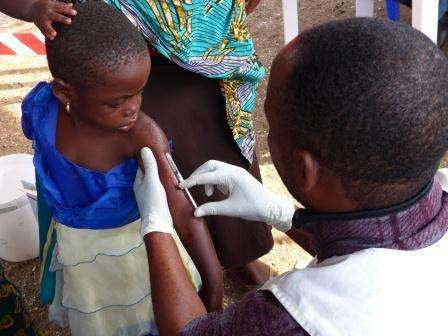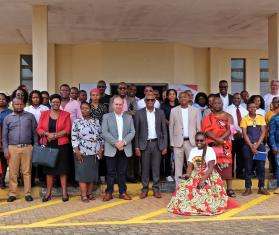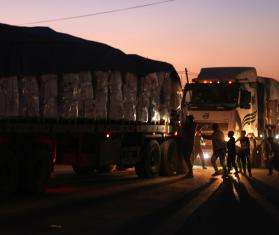Last week, the emergency unit of Doctors Without Borders Médecins Sans Frontières (MSF) in South Kivu ended a measles vaccination campaign in the district of Minova after reaching nearly 38,000 children and young people between 6 months to 15 years of age. The vaccination campaign in different parts of eastern DRC now continues in the neighboring district of Kalonge.
The immunization campaign took place for about three weeks, from June 27 to July 16, in four health areas (Lumbishi, Numbi, Shanje, and Tushunguti) in the hilly surroundings of the town of Minova, the so-called Hauts Plateaux. Moving in this environment is often very complicated as some areas can only be reached on foot or at best on motorcycle, and that makes it difficult to keep the necessary cold chain and to preserve the vaccines to be administered. Various armed groups are active in the area as well, and armed clashes make access to some remote spots even more complicated.
Although the initial goal was to vaccinate 25,000 people, the final number was nearly 38,000. This difference is due mainly to the lack of reliable data on the settled population in various parts of the country and to the arrival at vaccination posts of people from neighboring areas.
Almost two thirds of those vaccinated (23,257 of a total of 37,852 people) were children under five years old. Staff found that more than half of the smaller children (almost 15,000) were not malnourished by using a tool called a MUAC, which measures the circumference of the arm, They found that nearly 500 of them had some degree of malnutrition.
The emergency team has now moved on to the nearby area of Kalonge, also in South Kivu, where it will continue the vaccination campaign and is expected to immunize at least 65,000 more individuals in the next two weeks.
MSF teams have regularly intervened to help immunize the population and last year over a million people were vaccinated, but the routine immunization is not enough to prevent episodic outbreaks. In late 2012, one of these outbreaks affected more than 700 children in the district of Bunyakiri, near Minova.
Measles can be fatal in children if untreated, but is very easy to prevent by vaccination. It is an extremely contagious disease that can cause complications such as pneumonia, malnutrition, severe dehydration, ear infections, and eye infections that can lead to blindness. Mortality rates vary considerably depending on the context, but when a population has not been vaccinated, measles can end the lives of between one and 15 percent of children affected.
For decades, DRC has witnessed measles outbreaks and has seen a major resurgence of the disease since 2010. Since then measles has killed more than 4,500 people in the country, especially children under five years old. A retrospective study conducted by Epicentre, the epidemiological research MSF center, indicates that between 2010 and 2013 almost 300,000 measles cases were registered in the DRC (nearly two-thirds of them were children under five) and more than 5.000 patients died. According to this report, the cases fell by more than 20 percent after the vaccination campaigns started.





